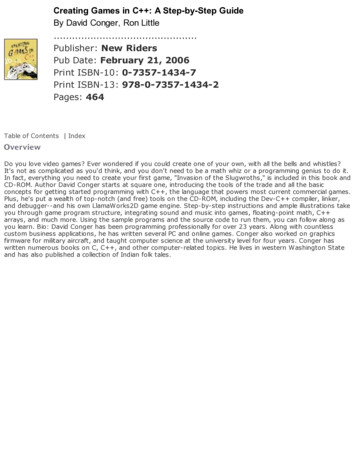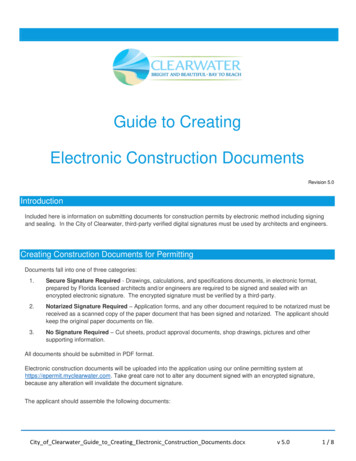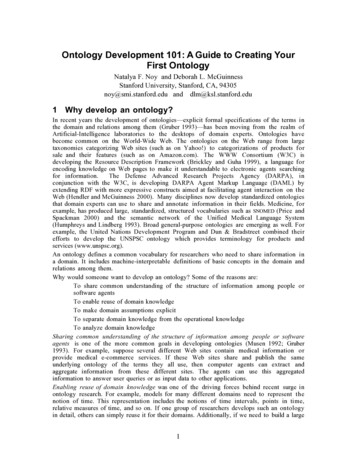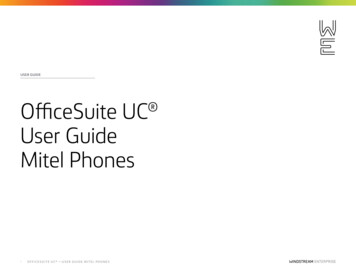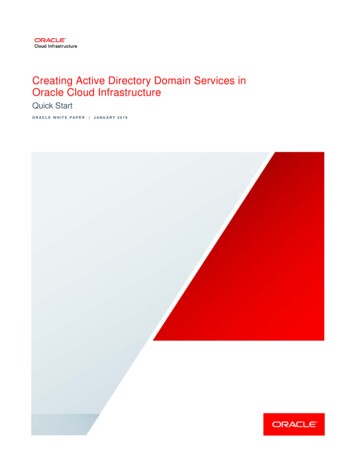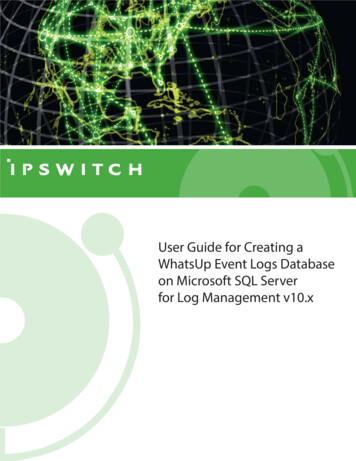
Transcription
User Guide for Creating aWhatsUp Event Logs Databaseon Microsoft SQL Serverfor Log Management v10.x
ContentsCreating a WhatsUp Event Logs Databaseon Microsoft SQL ServerPlease read the following topics in this help file thoroughly before beginning yourconfiguration of a WhatsUp Event Logs Database on Microsoft SQL Server.Click on any of the topics below to review them in depth.Microsoft SQL Server 2005 Instructions (on page 2)Microsoft SQL Server 2008 Instructions (on page 9)Legal Information Including Patent and Trademark NoticesWhatsUp Event Archiver is Copyright 1997-2011 Ipswitch, Inc. All Rights Reserved.WhatsUp Event Archiver is protected by U.S. Patent # 7,155,514. Other patents pending.WhatsUp Event Archiver, WhatsUp Event Analyst, WhatsUp Event Alarm, WhatsUp EventRover, and the WhatsUp word mark are trademarks or registered trademarks of Ipswitch, Inc.Microsoft Windows NT , Microsoft Windows 2000 , Microsoft Windows XP , MicrosoftWindows 2003 , Microsoft Windows Vista , Microsoft Windows Server 2008 , MicrosoftWindows 7, Microsoft Access , and Microsoft SQL Server are all registered trademarks ofMicrosoft Corp. Microsoft Windows NT , Microsoft Windows 2000 , Microsoft Windows XP ,Microsoft Windows 2003 , Microsoft Windows Vista , Microsoft Windows Server 2008 ,Microsoft Windows 7, Microsoft Access , Microsoft Exchange and Microsoft SQL Server willhereafter be referred to as NT, 2000, XP, 2003, Vista, 2008, Windows 7, Windows, Access,Exchange, and SQL Server respectively. Oracle is a registered trademark of the OracleCorporation. All other products or technologies not specifically mentioned here are theregistered trademarks of their respective companies, and are used by permission.Ipswitch Contact InformationIpswitch, Inc.83 Hartwell Avenue Lexington, MA 02421Phone: 781-676-5700 Fax: 781-240-5813WWW: http://www.whatsupgold.com1
Microsoft SQL Server 2005 InstructionsTo create an event logs database using Microsoft SQL Server 20051 Open the SQL Server Management Studio from the Start Menu2In the Object Explorer, right-mouse click the Databases folder, and select NewDatabase.2
3In the New Database Window, type in a new database name, such as "EventLogs."4Scroll to the right so that the Autogrowth column is fully visible. Click the ellipsis ( )buttons to turn off Autogrowth both for the database and transaction logs.3
5Verify that Autogrowth is disabled for both the database file and the transaction log file.Set appropriate initial sizes for both the database file and transaction log file in the InitialSize column. The initial size depends on how much data you collect with WhatsUp EventArchiver and is based on how big your log files grow per day per server. Per system logsize is typically a function of how many auditing policies are enabled on the system andthe amount of software installed on the computer. For a rough size estimate, considermultiplying: Number of servers/workstations X Number of logs X Size of average daily loggrowth X 1.5 X Number of days you wish to keep the log data in a database. Alternatively,access the Auditing Volume Analyzer tool from the WhatsUp Log Management ResourceTools program menu (Start menu WhatsUp Log Management Resource Tools) toperform this estimation of total log growth automatically.Under the Initial Size column for the transaction log file, set the initial size toapproximately 1/10th of the total size of your database file.4
6In the upper left corner, select the Options page. Set the Recovery Model of thedatabase to Simple. WhatsUp Event Archiver uses its own transaction system whenimporting data, so the Full model is not required. Setting the Recovery Model to Simplekeeps your transaction log from growing continuously.5
7Click OK to create your new Event Logs database with the settings you have selected.The bottom-left corner displays Executing while Microsoft SQL Server creates and sizesyour database. Depending on the size of your database and the speed of your hard diskor disk array, this may take many minutes or even an hour to complete.6
8If one or more of your WhatsUp Event Log Management Suite installations are notlocated on the same system as your Microsoft SQL Server, you may need to run theSurface Area Configuration Tool, allowing your SQL Server to accept data from WhatsUpEvent Log Management Suite systems. To do so, first select the tool from the Start menuunder the SQL Server program group:7
9Under the Remote Connections option, verify that your SQL Server is configured tolisten for local and remote connections. The type of connections the server accepts (e.g.TCP/IP, Named Pipes) is at your discretion. Remember, however, you must use aconnection type supported by the SQL Server when building ODBC connections from anWhatsUp Event Log Management Suite system.10 After creating and configuring your database, consult the Setting up and MakingConnections section of the main WhatsUp Event Archiver or WhatsUp Event Alarm HelpFile. This section discusses how to create an ODBC connection from the WhatsUp EventArchiver/Event Alarm system to your SQL server and shows how to create log tables onthat database.8
Microsoft SQL Server 2008 InstructionsTo create an event logs database using Microsoft SQL Server 20081 Open the SQL Server Management Studio from the Start Menu9
2In the Object Explorer, right-mouse click on the Databases folder, and select NewDatabase.10
3In the New Database Window, type a new database name, such as "EventLogs." Scroll tothe right so that the Autogrowth column is fully visible. Click the ellipsis ( ) buttons toturn off Autogrowth both for the database and transaction logs.4Verify that Autogrowth is disabled for both the database file and the transaction log file.Set appropriate initial sizes for both the database file and transaction log file in the InitialSize column. The initial size depends on how much data you collect with WhatsUpEvent Archiver and/or WhatsUp Event Alarm and is based on how big your log files growper day per server. Per system log size is typically a function of how many auditingpolicies are enabled on the system and the amount of software installed on thecomputer. For a rough size estimate, consider multiplying: Number ofservers/workstations X Number of logs X Size of average daily log growth X 1.5 XNumber of days you wish to keep the log data in a database. Alternatively, access theAuditing Volume Analyzer tool from the WhatsUp Event Log Management ResourceTools program menu (Start menu WhatsUp Log Management Resource Tools) toperform this estimation of total log growth automatically.11
Under the Initial Size column for the transaction log file, set the initial size toapproximately 1/10th of the total size of your database file.12
5Select the Options page. Set the Recovery Model of the database to Simple. WhatsUpEvent Archiver uses its own transaction system when importing data, so the Full modelis not required. Setting the Recovery Model to Simple keeps your transaction log fromgrowing continuously.13
6Click OK to create your new Event Logs database with the settings you have selected.The bottom-left corner displays Executing while Microsoft SQL Server creates and sizesyour database. Depending on the size of your database and the speed of your hard diskor disk array, this may take many minutes or even an hour to complete.7If you are using Microsoft SQL Server 2008 Express, it is recommended that you install itto the same system where the WhatsUp Event Log Management software (e.g. WhatsUpEvent Archiver, WhatsUp Event Analyst, etc) is installed. By default, remote connectionsare disabled in SQL Server 2008 Express. Remote connections can be enabled, but thesteps involved in doing so are beyond the scope of this documentation. For moreinformation on how to enable remote connections, please review this Microsoft MSDNarticle.8 Once your database has been created and configured, consult the Setting up andMaking Connections Section of the main WhatsUp Event Archiver or WhatsUp EventAlarm Help File. This section of the help file discusses how to create an ODBCconnection from the WhatsUp Event Archiver/Event Alarm system to your SQL serverand shows how to create log tables on that database.14
2 Microsoft SQL Server 2005 Instructions To create an event logs database using Microsoft SQL Server 2005 1 Open the SQL Server Management Studio from the Start Menu 2 In the Object Explorer, right-m
